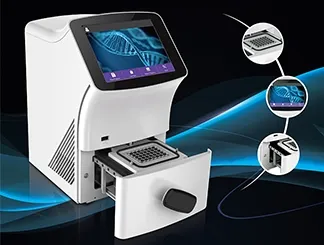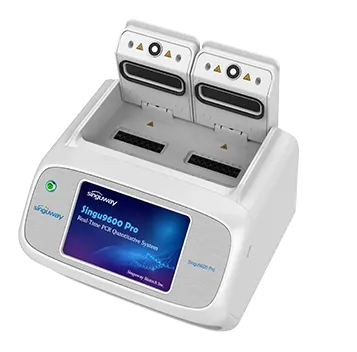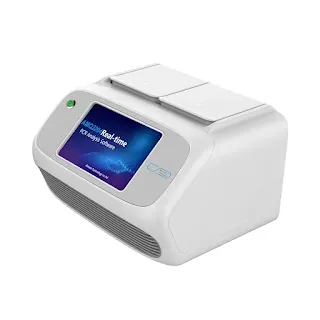DNA Sequencing and DNA Sequencers / Genetic Analyzers
Automated DNA Sequencing
DNA sequencing is the molecular biology technique that determines the precise order of nucleotide bases- adenine, guanine, cytosine and thymine, in a given template, or fragment, of DNA. Sequencing is used by researchers in molecular biology or genetics laboratories to further scientific progress or is used clinically to make medical treatment decisions and aid in genetic counselling.
The Maxim-Gilbert and Sanger manual techniques are used by smaller scale laboratories. The 1970’s technologies of Sanger’s chain termination, and Maxim, were improved upon and automated with ABI’s fully automated sequencing machine in 1987.
Since that time sequencing has gotten faster and cheaper; next generation sequencing has taken it to the level of complete genome sequencing in a matter of hours.
Advances in automated sequencing equipment allowed the Human Genome Project to be completed ahead of schedule. Laboratories requiring higher throughput, longer sequence reads and faster turnaround times can utilize automated sequencers which process 96 or 384 samples at one time.
Considerations for sequencing equipment and reagents include the size and complexity of the DNA template, the required turnaround time, the validation process, the laboratory space and budget available, and the number of samples to be processed. Advances in sequencing provide for an appropriate technology for small, medium and high-throughput sequencing requirements.
DNA Sequencers / Genetic Analyzers
Genetic analyzers are automated equipment that can analyze DNA fragments or sequence DNA for a range of purposes. DNA fragments attached to probes move through a polymer in capillary electrophoresis-based systems, where the fluorescence emissions are recorded. In a practical 96-well microplate format, sample loading is made possible by an array of many capillaries. For quick sequencing, other analyzers use pyrosequencing technology.
Applications of DNA Analyzer
Applications including Sanger sequencing, genotyping, mutation studies, methylation, and SNP and STR profiling are particularly well suited for these devices. Think about things like the necessary applications and acceptable throughput when choosing a genetic analyzer.
The DNA analyzer can be used for the following:
1. Forensic science
Forensic scientists frequently use molecular techniques, especially gene sequencing. To summarize, a DNA analyzer will significantly reduce the time required for DNA sequencing by replacing the majority of the manual labor that was previously performed. The risk of pollution spreading will be reduced as well. A DNA sampler can also be used to evaluate isolated DNA sequences.
2. studying microorganisms
Gene analysis of bacteria and viruses is a common method for studying microorganisms. As a result, a DNA analyzer can be an excellent substitute for several hours of manual labor.
3. Cancer-related research laboratories
The ability of the DNA sampler to detect genetic mutations will be invaluable in determining the underlying cause of cancer in laboratories specializing in cancer research.
4. DNA profiling
If blood is found at a crime scene, DNA profiling is performed. From Jeffrey's discovery of DNA fingerprinting to the development of PCR of STRs to the formation of DNA databases, our knowledge of DNA and DNA profiling have expanded greatly. Also, the applications for which we use DNA profiling have increased. DNA profiling has expanded to encompass paternity testing, disaster victim identification, monitoring bone marrow transplants, detecting fetal cells in a mother's blood, tracing human history, and a multitude of other areas.
Principles of DNA Analyzer Operation/ How DNA Analyzer Work
Sequencing and analyzing DNA fragments of various sizes is done using a DNA analyzer using capillary electrophoresis.
After inserting a cathode into the sample and applying an electric field, the negatively charged DNA began to move up the capillary towards the anode.
Because smaller DNA fragments move more swiftly than larger ones, they get to the detector faster. The DNA is connected to a fluorescently-labeled primer. After passing through the detection window, a laser's focused beam of light excites the fluorescent dyes, illuminating the DNA that the fluorescent primers were used to identify.
The wavelength of the excitation light is longer than that of the laser. These photons will enter the CCD (charged-coupled device) detector through the diffraction grating.
To find DNA, CCD uses wavelength technology. An internal size ladder, allelic ladder, and software detect the observed peaks and apply an allele label to the relevant location. The peaks of various fluorescent dyes can be added together to produce an electropherogram.
Advantages of DNA Analyzer
• Faster: DNA analyzers can analyze at least 48 samples with the assistance of only skilled personnel. As a result, it improves the efficiency of scientific research facilities.
• Less time-consuming: It saves time by processing multiple samples with minimal human intervention. It's also automated, so the worker can focus on anything else while the machine is running.
• Large sample processing capacity: The capillary array can process between 48 and 96 samples in parallel, allowing for a higher sample throughput.
• Less cross-contamination: Because robotic sample processing eliminates the need for human intervention, the risk of cross-contamination is reduced.
Using the DNA Analyzer
Calibration and proper setup are critical for effectively using a DNA analyzer. The calibration and initialization of the DNA analyzer consists of the following steps:
How to calibrate a DNA Analyzer
The DNA analyzer is calibrated both spatially and spectrally.
• Geometric calibration: The initial calibration of a measuring device is referred to as spatial calibration. The program must be uninstalled and reinstalled for this calibration. It is also done when the instrument is moved or when the capillary and plate are changed.
• Spectral calibration: A re-calibration is required when a new dye is introduced, the laser is adjusted, the CCD camera is replaced, abnormal peaks persist, or the plate capillary array is flipped. Calibration with a standard entails passing the standard through each capillary. The matrix from each capillary is approved or denied based on the spectral module of each standard. (The hardware and the module are both included.)
Configuring the Instrument
• Simply insert the appropriate capillary array into the device. After you've placed everything where it needs to be, perform some spatial calibration. Once you've decided on a polymer, insert the polymer-containing bag into the device.
• Determine whether there is enough polymer to last the entire cycle.
• Turn the autosampler forward, carefully disassemble each container, and empty the contents into the water and buffer reservoirs. After rinsing (first with deionized water, then with buffer/water) and cleaning (with lint-free clothing), slowly pour in 80 ml of the buffer and water in the appropriate container. By placing the buffer in the appropriate tray, closing the instrument door, and pressing the tray button, the autosampler can be moved to the desired location
Top Selling PCR DNA/RNA Analyzers
1. ICEN Portable 4/5/6 Channels Thermal Cycler PCR Test Kit Rapid PCR System DNA / RNA Real Time Quantitative PCR Test Machine
2. B-500 High Quality Biophotometer Laboratory Protein DNA Testing for DNA, RNA, and measure 0.5~2ūl samples 190nm~850nm
B-500 is a new designed model, suit for quick test of DNA, RNA, and Protein.
Features
■ Can measure 0.5~2ūl samples.
■ Quick measure without pre-warm.
■ There is no need to dilute the samples
■ Quick Scan, you can get the scanning curve in only 0.2 seconds.
■ Long life lamps, more than 2000 hours lifetime.
■Software comes standard with the instruments.
3. HC-B016E+ Real Time PCR System DNA Testing Machine PCR Machine
4. Laboratory DNA Analysis Fluorescence Quantitative Polymerase Chain Reaction PCR Analyzer LineGene K Plus
Feature Function
5. Laboratory Equipment RT Health Care 96 wells Real Time PCR Machine Instrument
6. Lab DNA Testing Real Time PCR Analyzer DNA Test Machine Fully Automated PCR
7. AMAIN Isothermal Amplification System AMH1601 PCR Analyzer DNA Test Machine
APPLICATION FIELD
FEATURE
8. DTC-4 PCR Gene Amplification Detection System for DNA analysis
KEY FEATURES
APPLICATIONS
9. Laboratory Analysis System Fluorescent Time Setting In Situ Hybridization Instrument for DNA Denaturation Test 12 SlidesSH2000
Features:
10. Laboratory Isocratic Thermal Cycler PCR Detector Gene Laboratory Equipment PCR Machine 0.2ml PCR Tube/PCR Plate/96-Well Plate
11. Hot Selling Horizontal Electrophoresis Tank for Test DNA/RNA Cell
- Fast electrophoresis running speed, the whole process can be finished within 15mins.
- 96 sample detection in one time
- Adding the sample quickly, suitable for the multi-channel pipettes. Auto-switch-off when the lid is removed.











